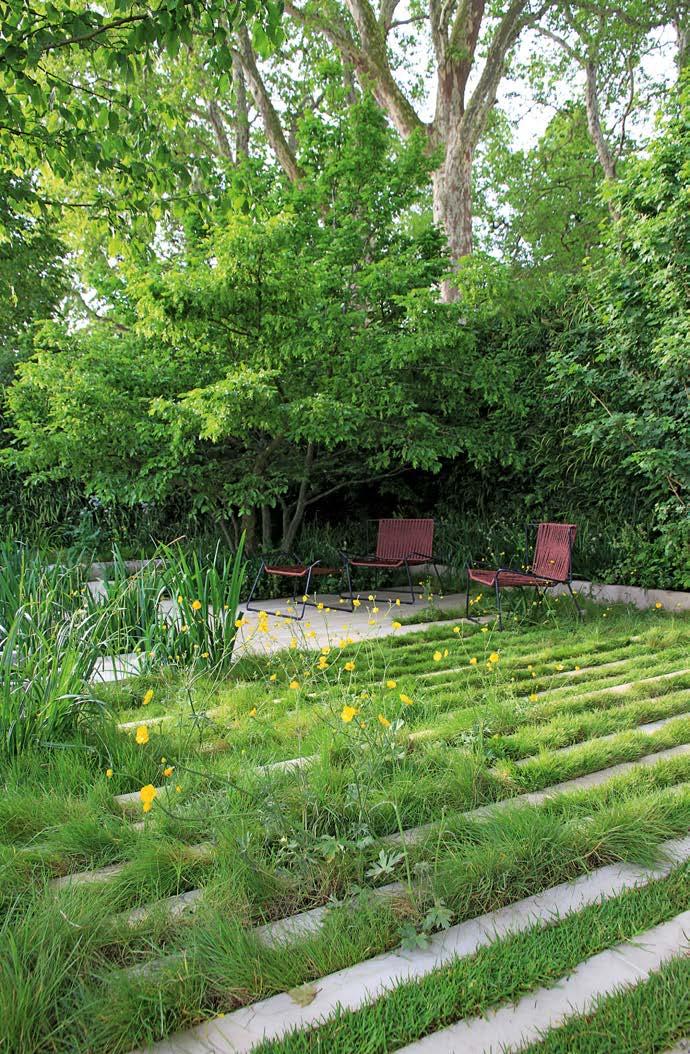
10 minute read
GREAT EXPECTATIONS A guide to finding a garden designer to suit
Great EXPECTATIONS
From bijou city havens to acres of lawn in the country, hiring a garden designer could be the key to unlocking a garden’s full potential
Few places have been as cherished as our gardens over the past year or so. No matter how large or small, whether rural or urban, they have offered us relief from the strains of this uncertain period. The rush on garden centres and nurseries over the spring and summer of 2020 points to how much our gardens have come to mean to us. However, putting in a few new plants every now and then may not be quite enough. If lockdown has engendered greater expectations from our gardens, hiring a garden designer could be just the thing to do.
Garden designers offer varying levels of service. It is possible to commission one to elevate a front garden, make changes to a terrace or overhaul dated planting, but good designers can also develop, for example, a country garden masterplan to be executed over many years, as and when time and funds allow. “A designer can offer a morning’s consultation or sketch a plan. It doesn’t need to be the full service, although for most designers the dream is to work on a complete garden and oversee the build,” explains Andrew Duff, designer, managing director of the Inchbald School of Design and vice-chair of the Society of Garden Designers (SGD).
Many, but certainly not all, designers will have some kind of qualification in garden design or landscape architecture. Well-known schools include KLC School of Design, Inchbald School of Design, London College of Garden Design, Writtle, Capel Manor and the Oxford College of Garden Design, all of which offer courses of varying lengths. Larger design firms might employ designers with degrees in landscape architecture.
ABOVE Alliums, lavender and classic English roses combine in this relaxed rhythmic planting by Thomas Hoblyn Garden Design.


LEFT Here designer Andrew Duff has created an inviting corner in which to shield from the sun on a hot day. ABOVE Think about how a space will be used and plant accordingly, such as in this terrace designed by Richard Miers. RIGHT A designer will help ensure that elements throughout the garden are cohesive.

However, whilst a qualification is a good indicator of ability, it does not automatically make someone a good designer. Some designers with a wealth of experience have had no formal training.
With its extensive search facility, the SGD is a good place to start looking for a designer. It is the industry professional body and accredited members must subscribe to a code of conduct, and hold up-to-date professional indemnity and public liability insurance. The SGD also offers conflict mediation in the rare event of a dispute. “Should a client and designer fall out, either party can come to the SGD and we are there to mediate,” says Duff. “But if it’s an honest relationship, disputes are unlikely.”
The SGD is an important part of the industry, but not every established designer is a member. A good way to gauge someone is to view their portfolio, which should be online, and social media channels – Instagram is a fair place to start. Clear communication from the outset is a good indicator of what will follow.
Duff advises sifting through a few designers to find those with an appealing design and work ethic. It is important to meet them more than once before making a final decision. Consider, too, how the garden will be used and draw up a list of requirements. In order to establish a visual representation of this, create a folder of images from magazines or online platforms, adding or removing images as preferences become clearer.
The designer should then develop a mood board to establish, as Duff puts it, that both parties are seeing the right shade of yellow. Do not be shy. Designers deal with a range of clients, from those who have no visualisation skills to experienced plantspeople, and are adept at determining what a client desires – and needs.
Principally a designer of country gardens, Angel Collins says one of the first questions she asks prospective clients is how much resource will be available to look after the garden once it is built. This determines the extent and nature of any hard landscaping, and what plants are used. Set a budget and be realistic about the time and money that can be commited, both for the build and to maintain it in years to come. “You can’t put in an amazing but high-maintenance garden and expect the owner to look after it if they’re not committed,” she says.
Both Duff and Collins stress that a good working relationship between client and designer underpins a good garden. “There are so many dimensions to this work, but




ABOVE Be prepared to wait for the right designer and landscaping contractor – the best may well have a waiting list. Helen Elks-Smith designed this garden. LEFT Visit gardens large and small for inspiration. At the National Trust property Tintihull, Penelope Hobhouse devised these bold container schemes. RIGHT A small garden with naturalistic planting by Andrew Duff. Sculpture by David Harber. LEFT Rousham House and Garden in Oxfordshire, is renowned for its timeless planting design.

MONEY TALK

Every project attracts a unique set of costs, ranging from a couple of thousand pounds to the millions. Whatever the size, obtaining clarity over what will be charged is essential
• Do expect quotes for the work, bearing in mind that day rates tend to be higher on smaller jobs but come down on bigger projects involving larger sums and longer time frames. • Make sure to understand the fee structure before work begins. It is not unusual for a deposit to be paid at the
outset and then for further sums to be paid at various stages of work. Costs might include travel, materials and ongoing maintenance if the company offers this. • Confirm the number of drawings that will be delivered. It is usual to pay for the delivery of each one. Ask for examples to ensure they are up to scratch.
ABOVE The view of Priest’s House from the White Garden in August at National Trust property Sissinghurst Castle Garden in Kent. Many have been inspired by the planting and design at this and many other National Trust properties for their own gardens. Visit nationaltrust. org.uk for details. when you have your first meeting you are already building a professional friendship. You want to really get on with the person you’ll be working with. And, as a designer, you want to give your life and soul to the project,” Collins explains.
After the first meeting, a topographical survey may be in order for larger gardens. This establishes the shape of the garden, which is foremost in the designer’s mind when they are designing, and will aid the landscapers who build the garden. “The survey is in my mind at all times,” says Collins. “Then you start to draw. You want something that is right for the countryside and house but also has an extra-special loveliness about it.” Country gardens in particular are influenced by their surroundings, be they pasture, woodland, hillside or water. City gardens might borrow the view of a neighbouring tree or hedge. A good designer will take this into account.
Designers work in individual ways. Larger, big-name firms will have a team of staff, and contact with the well-known designer at the

ABOVE Not every project needs to be a major undertaking. Many designers are happy to refresh existing features. This feature is by Angel Collins. RIGHT Angel Collins and other established designers of large country gardens often work from a masterplan executed over many years.
helm may be limited; smaller practices will be more intimate. Some designers specialise in design only, handing over their plans and planting lists and returning at the point of positioning plants if necessary. Others are involved in the entire process, working with landscapers and gardeners and helping to put in plants. Be clear from the outset and establish what the degree of engagement will be and who will be responsible for what.
Depending on the commission, it is worth allowing around six months for the process, from appointing the designer to completion. Be prepared to join a waiting list, both for the designer and the preferred landscaping contractor. Collins, who visits some gardens once a week, says: “I monitor my time and take on only what I can manage.” It may be the case that if building work is going on elsewhere on the property, the contractors for this may well also be willing to work on landscaping the garden. An architectural firm engaged to work on a house might be able to recommend landscape architects and designers it has worked with in the past. All will agree that the better the communication between them, the better the end result.
Gardens are lasting, personal spaces and it is important to feel completely happy with what is being paid for. Designers do have a stylistic signature, but their primary function is to implement their clients’ wishes and tastes in a practical but beautiful way. “I share everything with the client right from the start,” Duff explains. “I share the design process, which allows the client to feel invested in the design and gives them a chance to communicate what they like and don’t like.” n

LITTLE BLACK BOOK
Selected practices of varying sizes, offering garden styles from classic to contemporary
Acres Wild
Debbie Roberts and Ian Smith specialise in the design and master planning of larger country gardens in Sussex, Surrey, Kent, Hampshire and abroad. Tel: 01403 891084; acreswild.co.uk
Thomas Hoblyn Garden Design
City courtyards, large rural estates and commercial landscapes all pique the interest of Thomas Hoblyn, for whom project size is less important than the challenge. Tel: 01359 252 056; thomashoblyn.com
George Carter Garden Design
Specialises in formal spaces inspired by the geometry of seventeenth-century gardens, a style suiting both old and modern. Tel: 01362 668130; georgecartergardens.co.uk
Kate Gould Gardens
Renowned for chic, small, city gardens, especially in London. Larger urban gardens might be formal or more contemporary. Tel: 01923 839733; kategouldgardens.com
Richard Miers Garden Design
Richard Miers’ designs are clean and classically contemporary in style. Tel: 0207 8763765; richardmiers.com
Catherine Heatherington
Contemporary designs with an understanding and appreciation of traditional designs and techiniques. Catherine is an experienced London-based designer. Tel: 07786 518 386; chdesigns.com
Jo Thompson Landscape & Garden Design
Known for gently floriferous, winning designs often shown at RHS Chelsea, Jo has an international client list. Tel: 020 7127 8438; jothompson-garden-design.co.uk
Helen Elks-Smith Garden Design
Elks-Smith has a thoughtful approach to design and expertise in subtle, textural planting. She works around the South Coast, the Home Counties and London. Tel: 023 8178 2660; elks-smith.co.uk
Sue Townsend Garden Design
Simple lines, bold plants and materials sensitive to their surroundings, across East Anglia and occasionally in London. Tel: 01728 648790; suetownsendgardendesign.co.uk
Butter Wakefield Garden Design
Brings a country garden mood to smaller urban spaces, particularly in London but also elsewhere. Tel: 07973 516149; butterwakefield.co.uk
Iconic lighting, furniture and accessories sustainably handcrafted in England

Mullion Floor Light | Beeble Pouffe in Sea Grass
With the smallest ecological footprint possible, we forge a path to excellence, crafting the heirlooms of the future whilst protecting the natural world that inspires us.










